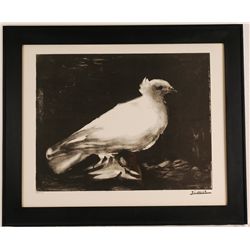Identification: 13 inches (33.02 cm) from top of head to bottom of tailfeathers. Can be distinguished from the Domestic Pigeon and the Rock Dove (Columba livia) by the white turtleneck tuft on the back of its neck. Plumage: off-white, opaline milky green or purple. Eyes low in head, level with beak. Flies higher than most other pigeons.
Song: can do the familiar coo-roo-coo of other doves, but, in certain urban zones, its call features exuberant, operatic glissandi and trills.
Habitat: urban and peri-urban areas; commonly roosts in cornices of industrial buildings and on masonry outcroppings on commercial structures.
Caesar called me to come over.
We sat on his roof in the late November sun. He tucked
the bird inside his worn wool vest, donating it a bit of his own heat.
It was the last of its kind. Columba regio civitatis. The Zoning Pigeon.
Ornithologists have long pretended the bird did not
exist. John James Audubon refused to include it in The Birds of America, which he published in chunks between 1827 and
1838. In his diary, he wrote that it was the one and only bird he felt was not
beautiful enough to paint. Roger Tory Peterson suppressed it from his
groundbreaking 1934 field guide, asserting in a note to his editor that its
existence was nothing more than urban myth.
But Caesar knew better. Once, Zoning Pigeons
darkened urban skies like pollution. Though not recognized by naturalists, they
were known to urban denizens for their calls, which changed depending on the
density and use of urban districts. The birds preferred mixed-use areas, and if
you found them there, their calls were swooping cadences that sounded as thrilling
as a coloratura aria sung by Luisa
Tetrazzini. In purely industrial zones, the birds developed a buzzing sound not
unlike a car alarm. And in regions dominated by office towers, Zoning Pigeons emitted
a heaving call that some described as a cross between laughing and throwing up.
The birds could also be quite destructive. Their guano pitted marble and
granite, and, if given time to seep in, damaged the structural integrity of
brick and mortar. Building managers banged pots and pans or blew off fireworks to
disperse the birds, which acted more like magpies than doves and stole anything
they could get their beaks on.
By the time Caesar got his bird – his friend
Victoria had found it with a broken wing after it fell (or was thrown) from the
roof of the former Tung Fa Noodle Building in Brooklyn – most people had
forgotten about them. Mixed used districts had given way to residential zones,
supers to doormen, factories to co-working spaces. The Zoning Pigeon was done
in by development, hunted and harried by special permits, bonuses, incentives
and those killers of all things good and natural, air rights transfers and upzonings.
All it needed in this world was air and a place to
breed – food was plentiful given how messy humans are – and these were
gradually taken away. Like the Passenger Pigeon before it, the bird was not
missed by the generations that didn’t know it.
Caesar, being the son and grandson of building
superintendents, knew immediately what it was. He named it Hector, nursed it
back to health – for a while he and Hector slept together – and then introduced
it in the wire mesh home he had built for his other doves. Hector seemed happy,
Caesar told me, except he wouldn’t flock with the rest of the crew. Instead, he
flew the other way. Ultimately, Caesar banded him with a GPS chip, so he could
track where Hector went. Sometimes he ventured to Yonkers or Jersey City, but
never further.
“Hector’s like me,” Caesar said. “He hates suburbs.”
For years, whenever he saw Caesar, Hector would sing.
But it was hardly the kind of melody the Zoning Pigeons of yore were reputed to
create. Rather, he spoke softly – a kind of sprechstimme
in a minor key, a dissonant plaintive chant.
 |
| Picasso's 1949 Dove of Peace |
Caesar cared for Hector for almost 25 years. But
when he called last November, he must have known the end was near. Hector had
stopped singing, stopped making any noise at all. Then, one day, he ceased flying,
and soon thereafter he stopped eating. It was as if his reason for existence
had gone. Here he was, the joyous bird of the melting pot, the symbol of
togetherness and possibility, meant to freewheel around the city, to be at home
in a live-and-let-live metropolis. And now his world was no more. The great
flocks were gone, wiped out by real estate. Human society had moved on. The
Zoning Pigeon hadn’t.
Victoria arrived soon after I did. Both of us could see
how weak Hector was. Just a heartbeat and some bone and feather. Nothing more. Caesar
rubbed the bird’s cowl and Hector snuggled closer.
We enjoyed the sun for most of the afternoon. Then we
heard a series of arrhythmic clicks, like a solenoid gone bad. Caesar put his
hand over his heart.
We sat for another hour and a half, listening.
The horns, the traffic, the voices, the sound
systems on the party boats moving up and down the river.
Our mouths puffed like little smokestacks.
Our hands clenched in our pockets like tree stumps.
Our thoughts emerged stillborn, like a scatter of
stones hitting a deep-frozen lake.
Caesar swore us to secrecy.
Victoria nodded. “The landlords. The superpowers. We
can’t let them know.” She was near tears.
“No crying,” Caesar commanded. His voice was heavy,
too. “We have to hide our emotion.”
He stood, cradling Hector’s body against his chest,
and opened the door to the birdhouse. The doves swarmed around him like a plume
from a volcano and for a glorious moment we could believe once again in the
age-old falsehoods: nothing has been lost, our city is immortal, survival is
guaranteed.
Never have we been as healthy as we
were during the epidemic.
Never have we been as peaceful as
we were during the battle.
Never have we made as much money as
we did during the crash.
Never have we been as safe as we
were during the emergency.
Never have we been as alive as we
were when we went extinct.
--The
Book of Derivatives®




No comments:
Post a Comment